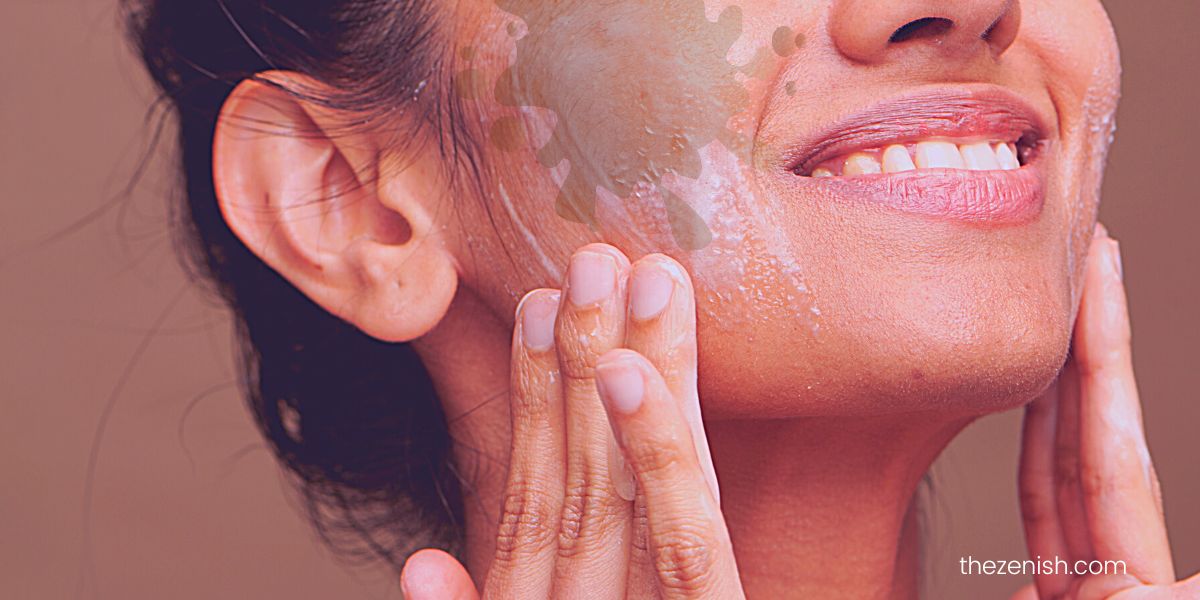Have you ever found yourself staring at those stubborn dark spots on your skin, wondering if they’ll ever go away? Yeah, I’ve been there.
Enter salicylic acid. It’s been getting some serious buzz as a potential solution for hyperpigmentation. But does it actually work? Does salicylic acid help hyperpigmentation?
Can salicylic acid really fade dark spots?

Let’s find out, let’s dive into the science behind salicylic acid and its effects on hyperpigmentation.
See also: 23 Best facial cleansers for dark spots and hyperpigmentation
What is hyperpigmentation?
Hyperpigmentation causes dark spots or uneven skin tone or dark patches on the skin. It occurs when your skin produces too much melanin, (the pigment that gives your skin its color).
It can affect anyone of all skin types but is more common for darker skin tones.
There are many different types of hyperpigmentation, including:
- Sunspots or age spots
- Post-inflammatory hyperpigmentation (PIH) caused by acne, eczema, or other skin conditions
- Melasma, which is caused by hormonal changes and is more common in women
Hyperpigmentation and the dark marks it creates can be embarrassing but it can also be a sign of sun damage or other skin issues. So consult with a dermatologist to determine the best course of action, as there are many treatments available for you.
See also: Acne Scar vs Hyperpigmentation: What’s the difference?
What causes hyperpigmentation?
Hyperpigmentation is common, and causes patches of your skin to get darker than the surrounding skin and can happen for various reasons, including:
- Exposure to the sun: UV rays can stimulate the production of melanin, which causes your skin to darken.
- Hormonal changes: Hormonal fluctuations during pregnancy or menopause can trigger hyperpigmentation.
- Inflammation: Skin inflammation caused by acne, eczema, or other skin conditions can lead to hyperpigmentation.
- Injuries: Burns, cuts, and other injuries can result in hyperpigmentation.
- Genetics: Some people are more prone to hyperpigmentation due to their genetic makeup.
The excess melanin production can be triggered by even minor skin injuries or irritations, and the resulting hyperpigmentation can be difficult to treat.
What is salicylic acid?
Salicylic acid is a type of beta hydroxy acid (BHA) derived from salicin, (a natural substance found in willow bark). It’s a popular and often key ingredient in many skin care products, especially ones used to treat acne and hyperpigmentation.
Salicylic acid (a chemical exfoliant) works by penetrating deep into your pores to dissolve excess oil and dead skin cells.
Its anti-inflammatory properties help reduce redness and swelling caused by acne and it’s safe and effective for all skin types, including sensitive skin, and is available in various forms, like cleansers, toners, serums, chemical peels and spot treatments.
So does salicylic acid help hyperpigmentation?
Yes, salicylic acid is also an effective treatment for hyperpigmentation and works by exfoliating the surface of the skin to remove dead skin cells and promote cell turnover.
Which all help to improve the overall tone and texture of your skin.
3 Ways salicylic acid helps fade hyperpigmentation
#1 Exfoliation
Salicylic acid exfoliates your skin penetrating deep into your pores and breaking down the bonds between dead skin cells.
This helps to unclog pores and remove the buildup of dead skin cells that can contribute to hyperpigmentation. By removing the top layer of dead skin cells, salicylic acid helps to reveal brighter, more even skin.
See also: 8 Exfoliating Mistakes You Should Avoid For Healthier Looking Skin
#2 Anti-inflammatory properties
In addition to its exfoliating, salicylic acid is also anti-inflammatory. This means that it helps reduce inflammation and redness in your skin.
When hyperpigmentation is caused by inflammation, such as in the case of post-inflammatory hyperpigmentation (PIH), salicylic acid can help to reduce the appearance of dark spots by reducing inflammation in the affected area.
#3 Skin lightening
Salicylic acid has been shown to have skin-lightening properties, which work by inhibiting the production of melanin, (the pigment that gives your skin its color).
By reducing the production of melanin, salicylic acid lightens dark spots and even out your skin tone over time.
Salicylic acid isn’t effective for all types of hyperpigmentation, such as melasma, which is caused by hormonal changes and is sometimes more difficult to treat.
10 Salicylic acid products for hyperpigmentation
These products are all highly rated and can help to fade hyperpigmentation over time with consistent use.
#1: Paula’s Choice Skin Perfecting 2% BHA Liquid Exfoliant
This cult-favourite exfoliating toner contains 2% salicylic acid to unclog pores and help fade dark spots and hyperpigmentation. It’s suitable for all skin types and has a lightweight, non-greasy texture.
#2: Drunk Elephant T.L.C. Framboos Glycolic Resurfacing Night Serum
While this serum contains both glycolic and salicylic acid, it’s a powerful exfoliator that can help to brighten the skin and fade hyperpigmentation. It’s suitable for most skin types and can be used up to three times a week.
#3: Sunday Riley U.F.O. Ultra-Clarifying Face Oil
This lightweight facial oil contains 1.5% salicylic acid to unclog pores and reduce the appearance of dark spots and hyperpigmentation. It’s also packed with nourishing ingredients like chamomile and neroli oil to soothe and calm the skin.
#4: Kate Somerville EradiKate Salicylic Acid Acne Treatment
While this treatment is marketed as an acne treatment, the 2% salicylic acid can also help to fade hyperpigmentation and acne scars over time. It’s a spot treatment that can be applied directly to blemishes or dark spots.
#5: SkinCeuticals Blemish + Age Defense Serum
This serum contains a combination of salicylic acid, glycolic acid, and other exfoliating ingredients to help fade hyperpigmentation, reduce the appearance of fine lines and wrinkles, and unclog pores.
#6: Dermalogica Overnight Clearing Gel
This lightweight gel contains 2% salicylic acid to help unclog pores and fade hyperpigmentation. It’s suitable for oily and acne-prone skin types and can be used as a spot treatment or all over the face.
#7: Kiehl’s Clearly Corrective Dark Spot Solution
This serum contains a blend of salicylic acid, vitamin C, and white birch extract to help fade hyperpigmentation and brighten the skin. It’s suitable for all skin types and can be used day or night.
#8: La Roche-Posay Effaclar Duo Dual Action Acne Treatment
This acne treatment contains 0.5% salicylic acid to help unclog pores and fade hyperpigmentation. It also contains niacinamide to help reduce redness and inflammation.
#9: Murad Rapid Age Spot and Pigment Lightening Serum
This serum contains 2% hydroquinone and 0.5% salicylic acid to help fade hyperpigmentation and age spots. It’s suitable for most skin types and can be used day or night.
#10: Glow Recipe Watermelon Glow PHA + BHA Pore-Tight Toner
While this toner contains both PHA and salicylic acid, it’s a gentle exfoliating toner that can help to brighten the skin and fade hyperpigmentation over time. It’s suitable for all skin types and has a refreshing, watermelon scent.
How to use salicylic acid for hyperpigmentation?
Salicylic acid is an effective treatment for hyperpigmentation, but it’s important you use it correctly to get the best results. Here are some tips for using salicylic acid for hyperpigmentation:
- Start with a low concentration: If you’ve never used salicylic acid before, start with a low concentration, such as 0.5% or 1%. You can gradually increase the concentration as your skin gets used to the treatment.
- Use it once a day: Apply salicylic acid to the affected area once a day, preferably at night. Using it more frequently can irritate your skin and make hyperpigmentation worse.
- Cleanse your skin before applying: Cleanse your skin before applying salicylic acid to remove any dirt, oil, or makeup that can block the pores and prevent the treatment from penetrating the skin.
- Apply a thin layer: Apply a thin layer of salicylic acid to the affected area and let it dry before applying any other skincare products or makeup.
- Wear sunscreen: Salicylic acid can make your skin more sensitive to the sun, so it’s crucial to wear sunscreen with SPF 30 or higher daily to protect your skin from further damage.
See also: Do I need sunscreen if my moisturizer has SPF?
Be patient when using salicylic acid. It can take several weeks or even months before you see significant results.
If you experience any irritation or discomfort, reduce the frequency of use or stop using it altogether and consult a dermatologist.
Potential side effects of using salicylic acid
Although salicylic acid is generally considered safe, it can cause some side effects, especially when first starting to use it.
- One of the most common side effects of using salicylic acid is irritation. This can result in redness, itching, and peeling.
In some cases, it may even cause a burning or stinging sensation. If you experience any of these symptoms, use it less frequently, stop using it altogether or consult with a dermatologist.
- Another potential side effect of using salicylic acid is dry skin, as it can remove too much oil from your skin, resulting in dryness and potential irritation. To avoid this, make sure to moisturize your skin regularly when using salicylic acid.
In rare cases, salicylic acid can cause an allergic reaction. If you experience symptoms such as swelling, hives, or difficulty breathing, seek medical attention immediately.
- Using salicylic acid can also make your skin more sensitive to the sun, increasing your risk of sunburns and other sun damage. So remember to use sunscreen with an SPF of at least 30 when using this acid.
And finally, avoid using salicylic acid with other exfoliating products, such as retinoids or another alpha hydroxy acid, as this can increase the risk of skin irritation.
7 Other ingredients that can help fade hyperpigmentation
Salicylic acid isn’t the only ingredient out there that can help fade hyperpigmentation. Here are a few other ingredients to look out for:
- Vitamin C: A powerful antioxidant that can help brighten your skin and fade dark spots.
- Retinoids: A derivative of vitamin A that can help speed up cell turnover and fade hyperpigmentation.
- Kojic acid: A natural ingredient derived from mushrooms that can inhibit the production of melanin and lighten dark spots.
- Azelaic acid: A gentle acid that can reduce inflammation and fade hyperpigmentation.
- Glycolic acid: A popular AHA that can help exfoliate the skin and fade dark spots.
- Lactic acid: Another AHA that can help exfoliate the skin and fade hyperpigmentation, while also being gentler than other AHAs.
- Arbutin: A natural ingredient derived from plants like bearberry and blueberry that can inhibit the production of melanin and lighten dark spots.
FAQs
How long does it take for salicylic acid to work on hyperpigmentation?
The time it takes for salicylic acid to help fade hyperpigmentation can vary for many different reasons.
But generally speaking, you can expect to start seeing some improvement after about 4-6 weeks of consistent use. This time frame can change based on the severity of your hyperpigmentation, how often you’re using salicylic acid, the concentration (salicylic acid peels are usually more concentrated) and what other skincare products you’re using in conjunction with it.
Remember salicylic acid isn’t a miracle cure, but it can certainly help improve the appearance of dark spots over time.
If you’re dealing with stubborn hyperpigmentation, it’s a good idea to consult with a dermatologist who can help you come up with a targeted treatment plan that works for your skin.
Overall, patience is key when it comes to skincare, so keep at it and be consistent with your routine; you will likely start to see positive changes in your hyperpigmentation over time!
Can salicylic acid lighten dark spots?
Salicylic acid isn’t necessarily a skin lightener in the traditional sense, but it can certainly help to fade dark spots over time.
So, how does it work?
Salicylic (a type of beta-hydroxy acid (BHA)) works by exfoliating the skin and increasing cell turnover. Which helps to break up excess melanin that can cause dark spots and hyperpigmentation, ultimately leading to a brighter, more even complexion.
Salicylic acid isn’t a miracle cure for dark spots, but consistent use can help fade them over time.
It’s also important to use sunscreen to protect your skin from further damage, as sun exposure can exacerbate hyperpigmentation and make it harder to fade.
Final thoughts
Salicylic acid can help fade hyperpigmentation. However, results vary depending on the severity, the concentration of salicylic acid used, how long you’ve been using it and your skin type.
While salicylic acid is generally safe for most people, it can cause skin irritation, dryness, and peeling. It’s better to start with a lower concentration and gradually increase it as tolerated. And don’t forget to use sunscreen to avoid sun exposure to prevent further hyperpigmentation.



